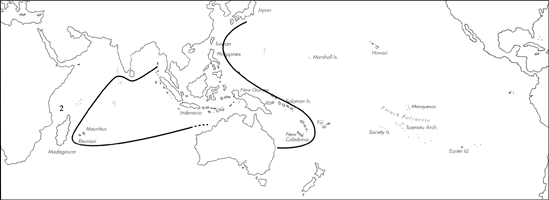Range: RĂ©union and Maldives to New Caledonia and to Japan.
Description: Moderately small to medium-sized, moderately solid. Last whorl conical to slightly pyriform; outline variably convex adapically and straight to slightly concave below. Shoulder angulate, undulate to tuberculate. Spire of moderate height, outline concave to slightly sigmoid. Larval shell of 3.25 whorls, maximum diameter about 0.8 mm. Early postnuclear spire whorls smoothly edged; late whorls undulate to tuberculate. Teleoconch sutural ramps flat, with arcuate radial threads and 1 increasing to 3-4 spiral grooves. Last whorl with widely spaced, granulose spiral ribs, restricted to basal area or extending to shoulder.
| Shell Morphometry | ||
|---|---|---|
| L | 30-59 mm | |
| RW | 0.12-0.20 g/mm | |
| (L 30-44 mm) | ||
| RD | 0.59-0.70 | |
| PMD | 0.84-0.94 | |
| RSH | 0.15-0.22 | |
Ground colour white. Last whorl encircled with 2 variably wide, tan to orangish brown bands, on each side of centre. Populations may include intensely banded and largely white shells. Adapical band often overlaid with or divided by spirally or axially aligned dots. Base, siphonal fasciole and basal part of columella light violet. Larval whorls orange. Teleoconch sutural ramps with tan radial markings matching pattern of last whorl in colour. Aperture light violet at base, translucent white above.
Periostracum greyish olive, thin, and translucent to almost opaque, with finely tufted spiral lines and distinct radial folds on sutural ramps.
Dorsum of foot pale pink, grading to red anteriorly and to brownish red posteriorly; black and white dots centrally and posteriorly; anterior part with a single black spot. Sole of foot beige dotted with white. Rostrum and tentacles red. Siphon red, dotted with black and white, paler proximally (Pl. 74, Fig. 14) (Chaberman, pers. comm. 1981).
Radular teeth slender, with an adapical barb opposite a blade; serration absent but basal spur present (Rolán, pers. comm., 1992)
Habitat and Habits: In 9-80 m; reported to be dredged to 240 m in the Philippines. In Papua New Guinea, in muddy sand or on living coral in 9-80 m; in New Caledonia, on coarse sand or coral rubble and algae in 25-80 m (Estival, 1981; Tirard, pers. comm., 1989; Richards, pers. comm., 1989; Chaberman, pers. comm., 1981).
Discussion: C. floridulus resembles the typical form of C. muriculatus in shell and animal. For comparison, see the Discussion of the latter species.

C. floridulus Range Map
This section contains verbatim reproductions of the accounts of 316 species of Conus from the Indo-Pacific region, from Manual of the Living Conidae, by Röckel, Korn and Kohn (1995). They are reproduced with the kind permission of the present publisher, Conchbooks.
All plates and figures referred to in the text are also in Röckel, Korn & Kohn, 1995. Manual of the Living Conidae Vol. 1: Indo-Pacific Region.
The range maps have been modified so that each species account has it own map, rather than one map that showed the ranges of several species in the original work. This was necessary because each species account is on a separate page on the website and not confined to the order of accounts in the book.